July 2024
It's a process
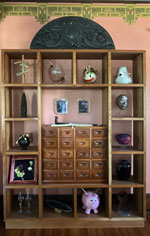 Many years ago, I watched a corporate training video by the actor John Cleese (Yes, really – the Monty Python guy). The topic was the “value” of making mistakes. Essentially, he said that learning from mistakes was a valuable element of the process of finding good results. I can tell you that I find this to be an especially true experience in one of my side gigs. Making furniture is that gig, and I have innumerable mistakes buried in the work. If Cleese’s advice is sound, I might be getting better. Honestly, though, it’s sometimes hard to tell. Many years ago, I watched a corporate training video by the actor John Cleese (Yes, really – the Monty Python guy). The topic was the “value” of making mistakes. Essentially, he said that learning from mistakes was a valuable element of the process of finding good results. I can tell you that I find this to be an especially true experience in one of my side gigs. Making furniture is that gig, and I have innumerable mistakes buried in the work. If Cleese’s advice is sound, I might be getting better. Honestly, though, it’s sometimes hard to tell.
Examples:
The Sculpture Case
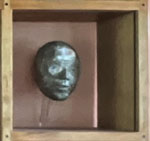 Squareness is Sometimes Critical Squareness is Sometimes Critical
Although this piece was separable into sections so it could be moved, each section was bigger than any of my clamping devices could manage as the glue-ups cured. I thought I could get by with spot checks on individual areas. That was a mistake. When finally fully assembled, I found that it was out of square by a fraction of a degree. The center chest purchased in Thailand just barely fit into place. I won’t make that mistake again.
The "Simple" Desk
Pay Attention to the Instructions
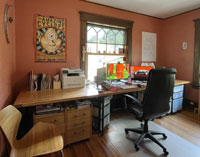 Most of the desktop consists of glue-ups of 1x4 cherry boards. After laying out the first section, I cut multiple slots to insert biscuits, which would be used to maintain alignment of the clamped boards as the glue cured. All advice tells you that the typical biscuit of compressed beech will expand slightly from the moisture of the glue. This is actually intentional. However, with 9 boards and multiple biscuits per board, there was so much expansion that no matter how hard I screwed down the clamps I couldn’t get the joints to close. As the glue was drying in front I me, I had to take out all the biscuits; and clamped things together with the inevitable unevenness. I didn’t make that mistake again, and did the other glue-ups with no biscuits.
Most of the desktop consists of glue-ups of 1x4 cherry boards. After laying out the first section, I cut multiple slots to insert biscuits, which would be used to maintain alignment of the clamped boards as the glue cured. All advice tells you that the typical biscuit of compressed beech will expand slightly from the moisture of the glue. This is actually intentional. However, with 9 boards and multiple biscuits per board, there was so much expansion that no matter how hard I screwed down the clamps I couldn’t get the joints to close. As the glue was drying in front I me, I had to take out all the biscuits; and clamped things together with the inevitable unevenness. I didn’t make that mistake again, and did the other glue-ups with no biscuits.
Be Cautious with "Experiments"
At 12 feet long, the desk could not easily be moved in one piece. Since I wanted the appearance of it being a single piece, I designed a joinery detail that interlocked the adjoining sections with a “sawtooth” arrangement of the boards – much like the coursing of running bond brickwork. What I did not account for was the minuscule differences in the boards and their slightly differing expansion rates. After glue-up they simply would not link together. This brought on many days of sanding, modifications, and swearing as I finally got things to go together. It was not pretty, and I knew it had to be done all over again after finishing and relocation to the office. I won’t make that mistake again.
Outdoor Furniture
Saving Money Takes Effort
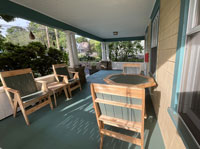 I was intimidated by the current prices for the wood used for outdoor furniture. Redwood, teak, and the various species of mahogany now come with eye-watering prices. Cedar seemed to be the only “affordable” option. But… The less expensive grades have lots of knots and less than ideal finish. I scrounged through the stock available to me at the home centers to find the best material. Even so, there was lots of waste, as I worked around the less-than-ideal sections of each board. I suppose this was more like a “lesson Learned” than a mistake. Still, I learned. I was intimidated by the current prices for the wood used for outdoor furniture. Redwood, teak, and the various species of mahogany now come with eye-watering prices. Cedar seemed to be the only “affordable” option. But… The less expensive grades have lots of knots and less than ideal finish. I scrounged through the stock available to me at the home centers to find the best material. Even so, there was lots of waste, as I worked around the less-than-ideal sections of each board. I suppose this was more like a “lesson Learned” than a mistake. Still, I learned.
Watch Out for Unintended Consequences 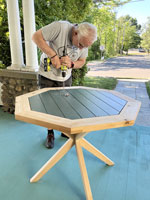 Aside from the compromise of cedar selection, I made the choice to experiment. (See caution noted above.) The colored material is not wood. Its High Density Polyethylene (HDPE) – the same material commonly used for cutting boards. Touted for its low maintenance and integral color, I thought it was a reasonable choice in lieu of anything that was painted. Was this a mistake? Time will tell. Aside from the compromise of cedar selection, I made the choice to experiment. (See caution noted above.) The colored material is not wood. Its High Density Polyethylene (HDPE) – the same material commonly used for cutting boards. Touted for its low maintenance and integral color, I thought it was a reasonable choice in lieu of anything that was painted. Was this a mistake? Time will tell.
OK, What's My Point?
Getting back to John Cleese’s advice – mistakes have value. Fear of making mistakes is an inhibitor of innovation and progress. Whether it’s in the application of a new business practice, the use of a material, the encouragement of young talent – or experiments in furniture construction. They all (as well as the many likely to arise) should be embraced.
But that acceptance, should not be without guardrails. Group acknowledgment of the approach, knowing there could be unintended consequences is critical. A willingness to retrench if things do not go as planned or hoped is useful. And especially important is a positive attitude in the times of almost predictable adversity.
I think I’m a better woodworker than I was a year ago. I’ll wager you could have better business results if mistakes were part of the approach. Ask John Cleese.
PS, Some online resources:
https://www.youtube.com/watch?v=T_RUg4jvCXE
https://www.openculture.com/2016/01/john-cleese-on-the-importance-of-making-and-embracing-mistakes.html
PPS, Ignore any of Cleese's recent politics. They're dubious.
January 2024 “Pencils Down"
August 2023 “Carpentry Therapy"
March 2023 “When? please tell me when"
September 2022 “
The New Normal"
March 2022 “
Facilities Management – My Way"
January 2022 “Report Writing for Dummies"
October 2021 “Writer's Block and Other Musings"
May 2021 “Lower Ed?”
September 2020 “Just Stylin'”
July 2020 “Reflections on Our Covid Times”
February 2020 “Quirky Clients – The Smart Version”
September 2019 “OPM Cheerleader”
June 2019 “Can You Perform?”
February 2019 “Today's Word”
October 2018 “The Case for DIversity-Architect's Version”
June 2018 “A Capital Idea”
March 2018 “Me Too?”
January 2018 “R U Trending?”
October 2017 “Do You Measure Up?”
August 2017 “I'm an Architect and I'm Here to Help”
January 2017 “The Future of Higher Education”
November 2016 “The Owner as CM?”
August 2016 “Don't you just hate...”
June 2016 “Duck Testing”
April 2016 “Once Upon a Time...”
January 2016 “I want to take you higher”
November 2015 “Moderating in all Things?”
July 2015 “Alphabet City”
May 2015 “Acey Trey Trey Trey?”
January 2015 “Nature or Nurture?”
August 2014 “Acey Trey Trey?”
June 2014 “The Seven Deadly Sins”
March 2014 “Thar She Blows!”
November 2013 “Giving Thanks”
September 2013 “Back to School?”
June 2013 “What Time is It?”
March 2013 “Acey Deucey?”
January 2013 “A Swamp Full of Alligators”
October 2012 “Plan to Live Forever, Part Deux”
July 2012 “A Midsummer Dream”
May 2012 “Are you Virtually Working?”
March 2012 “Your Huddled Masses”
January 2012 “Observing Observations”
October 2011 “I Want What I Want”
August 2011 “A Beach Read”
May 2011 “NeoLuddite or Technophile?”
March 2011 “Do Your Silos Leak?”
January 2011 “Plan to Live Forever!”
November 2010 “May I Have A Plan, Master?”
September 2010 “How do we choose?”
July 2010 “Good People Behaving Badly”
May 2010 “LEED: LEADing or Dead Weight?”
March 2010 “Why does it cost so much?”
January 2010 “Design/Builders show us your softer side.”
November 2009 “What the Facilities?”
September 2009 “Why Do Architects Make Good Owner’s Reps?” |
 I was intimidated by the current prices for the wood used for outdoor furniture. Redwood, teak, and the various species of mahogany now come with eye-watering prices. Cedar seemed to be the only “affordable” option. But… The less expensive grades have lots of knots and less than ideal finish. I scrounged through the stock available to me at the home centers to find the best material. Even so, there was lots of waste, as I worked around the less-than-ideal sections of each board. I suppose this was more like a “lesson Learned” than a mistake. Still, I learned.
I was intimidated by the current prices for the wood used for outdoor furniture. Redwood, teak, and the various species of mahogany now come with eye-watering prices. Cedar seemed to be the only “affordable” option. But… The less expensive grades have lots of knots and less than ideal finish. I scrounged through the stock available to me at the home centers to find the best material. Even so, there was lots of waste, as I worked around the less-than-ideal sections of each board. I suppose this was more like a “lesson Learned” than a mistake. Still, I learned.
 Many years ago, I watched a corporate training video by the actor John Cleese (Yes, really – the Monty Python guy). The topic was the “value” of making mistakes. Essentially, he said that learning from mistakes was a valuable element of the process of finding good results. I can tell you that I find this to be an especially true experience in one of my side gigs. Making furniture is that gig, and I have innumerable mistakes buried in the work. If Cleese’s advice is sound, I might be getting better. Honestly, though, it’s sometimes hard to tell.
Many years ago, I watched a corporate training video by the actor John Cleese (Yes, really – the Monty Python guy). The topic was the “value” of making mistakes. Essentially, he said that learning from mistakes was a valuable element of the process of finding good results. I can tell you that I find this to be an especially true experience in one of my side gigs. Making furniture is that gig, and I have innumerable mistakes buried in the work. If Cleese’s advice is sound, I might be getting better. Honestly, though, it’s sometimes hard to tell. 
 Most of the desktop consists of glue-ups of 1x4 cherry boards. After laying out the first section, I cut multiple slots to insert biscuits, which would be used to maintain alignment of the clamped boards as the glue cured. All advice tells you that the typical biscuit of compressed beech will expand slightly from the moisture of the glue. This is actually intentional. However, with 9 boards and multiple biscuits per board, there was so much expansion that no matter how hard I screwed down the clamps I couldn’t get the joints to close. As the glue was drying in front I me, I had to take out all the biscuits; and clamped things together with the inevitable unevenness. I didn’t make that mistake again, and did the other glue-ups with no biscuits.
Most of the desktop consists of glue-ups of 1x4 cherry boards. After laying out the first section, I cut multiple slots to insert biscuits, which would be used to maintain alignment of the clamped boards as the glue cured. All advice tells you that the typical biscuit of compressed beech will expand slightly from the moisture of the glue. This is actually intentional. However, with 9 boards and multiple biscuits per board, there was so much expansion that no matter how hard I screwed down the clamps I couldn’t get the joints to close. As the glue was drying in front I me, I had to take out all the biscuits; and clamped things together with the inevitable unevenness. I didn’t make that mistake again, and did the other glue-ups with no biscuits. Aside from the compromise of cedar selection, I made the choice to experiment. (See caution noted above.) The colored material is not wood. Its High Density Polyethylene (HDPE) – the same material commonly used for cutting boards. Touted for its low maintenance and integral color, I thought it was a reasonable choice in lieu of anything that was painted. Was this a mistake? Time will tell.
Aside from the compromise of cedar selection, I made the choice to experiment. (See caution noted above.) The colored material is not wood. Its High Density Polyethylene (HDPE) – the same material commonly used for cutting boards. Touted for its low maintenance and integral color, I thought it was a reasonable choice in lieu of anything that was painted. Was this a mistake? Time will tell.